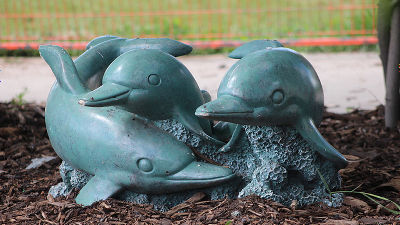During the development of a translator for talking with dolphins, during the year also experiments targeting wild dolphins

In order to talk to dolphins which are said to be particularly intelligent among animals, a project is under way to elucidate the language of dolphins using translators.
It is possible on the specification that you can reply in real time although it has few words, and if you can grasp the clue about the language of dolphins in this project, it may be one step closer to human dream of talking with animals .
Details of the translator and the project using it to realize the conversation with dolphins are as follows.Talk with a dolphin via underwater translation machine - tech - 09 May 2011 - New Scientist
A device that recognizes the dolphins' barking and enables real-time reply is ready for operation soon and will be tested conversation with wild dolphins off Florida when it is completed. When I hear that translator, the word of dolphins will be converted to human language immediately, but this time the machinery produced this time, in order for dolphin and human to communicate bidirectionally, the meaning of dolphin's bark It was made for the purpose of elucidating.
Dolphins are known as highly intelligent animals, and dolphins kept by humans from around the 1960 's used cries and pictures to communicate with humans. In the 1990s, Louis Herman of the Kewalo Bay marine mammalian laboratory in Honolulu, Hawaii revealed that Bottlenose dolphin can understand more than 100 words, different reactions depending on the order in which same words are used I showed you. For example, clearly the difference between the sentence "bring the surfboard to the man" and the sentence "bring the man to the surfboard (please bring men to the surfboard)" He seems to have understood it.
Denise Herzing, founder of "the Wild Dolphin Project" says, "In the previous experiments," communication "was only one way, the way researchers first made a system to let dolphins learn it It was taken, I think that the opportunity for the dolphin side to speak was hardly given, "I pointed out the part lacking in the previous experiment and started an attempt to enable two-way communication.
The first attempt was made in 1998, Herzing and his colleagues created a device that associated artificial sounds with "keyboard" with four large icons set underwater, and the dolphins face the icon towards the icon , We made it possible to select things you like from among options such as "Play with seaweed" and "Play on the bow wave that diver takes". Although this device irritated the dolphin's interest, it was not easy for the dolphin to use, so he did not get enough communication.
And now, Mr. Herzing is engaged in a project called "Cetacean Hearing and Telemetry (CHAT)" which is a joint research with Thad Starner who is studying artificial intelligence at the Georgia Institute of Technology. In this project, the wild dolphin grasps the characteristics of the barking sounds that are originating in the natural world, and it is going to progress in such a way as to co-create the dolphin and language.
The dolphin is able to give up to the sound of 200 kilohertz which is about 10 times the highest sound range that humans can hear, and furthermore the pitch and length of the bark can be changed freely. Moreover, although it is possible to change the direction to skip the sound without swaying the head, there are parts where it is hard to observe which dolphin cries in the herd due to that special skill, and by tracing the meaning of the sound, It is said that he decides to deduce what the dolphins in are saying.

Starner and his students have produced a prototype for the translator. It is about the size of a smartphone, equipped with two underwater sounds capable of capturing the whole frequency of the dolphin's singing voice. When actually using it, it is supposed that the diver puts a translation machine in the waterproof case and carries it with crowning on his / her chest. LED is embedded in the mask for diver, it has become specification to let you know by shining dolphin's cry at places where you can record, operate the input device "Twiddler" which combines mouse and keyboard It is also said that it is also possible to select which cry to return a reply.
When using this translator, Divers firstly reproduces words such as "seaweed" and "get on the bow wave" which were generated by the human side, let the software first recognize whether the dolphins will imitate it, As the next step, I will move on to extract outstanding features of barking which may be the basic unit of words used for dolphin communication.
We are not yet considering whether basic units of communication exist yet, but the algorithms prepared by them are set to pick up interesting features from unknown data, and about contents with similar tendencies The group is going to work and it seems that the work will be iterated until all the features are extracted from the bark.
When the basic unit thus extracted is confirmed, Mr. Herzing combines them to make a cry similar to the dolphin, and by letting the dolphin hear it again, the dolphins are more interesting than the words made by humans I am expecting that I can discover "words" that I have. Herzing may be the first person to decipher the foundation of the dolphin's natural language if it can successfully connect the sounds found by the translator with specific objects and behaviors.
Justin Gregg of the non-profit organization "the Dolphin Communication Project" said, "If you do that experiment, it's definitely wild The dolphins may start using it while remembering the artificial "words", but I think that we can not reach the goal of finding the basic unit of the natural language they are using, as if they were aliens It came as an elaborate cosmic clothes and it seems like you are making meaningless calls by random word selection regardless of who you are. "
Herzing said, "To be sure, we do not yet know whether dolphins are manipulating the language, but if we can understand the cries they emit, that We should be able to manipulate it, "he asserts again the significance of the experiment.
Mr. Herzing and Starner says that we plan to start experimenting the translation machine for the spotted dolphins living in the Atlantic in the middle of 2011.
Related Posts:
in Creature, Posted by darkhorse_log







